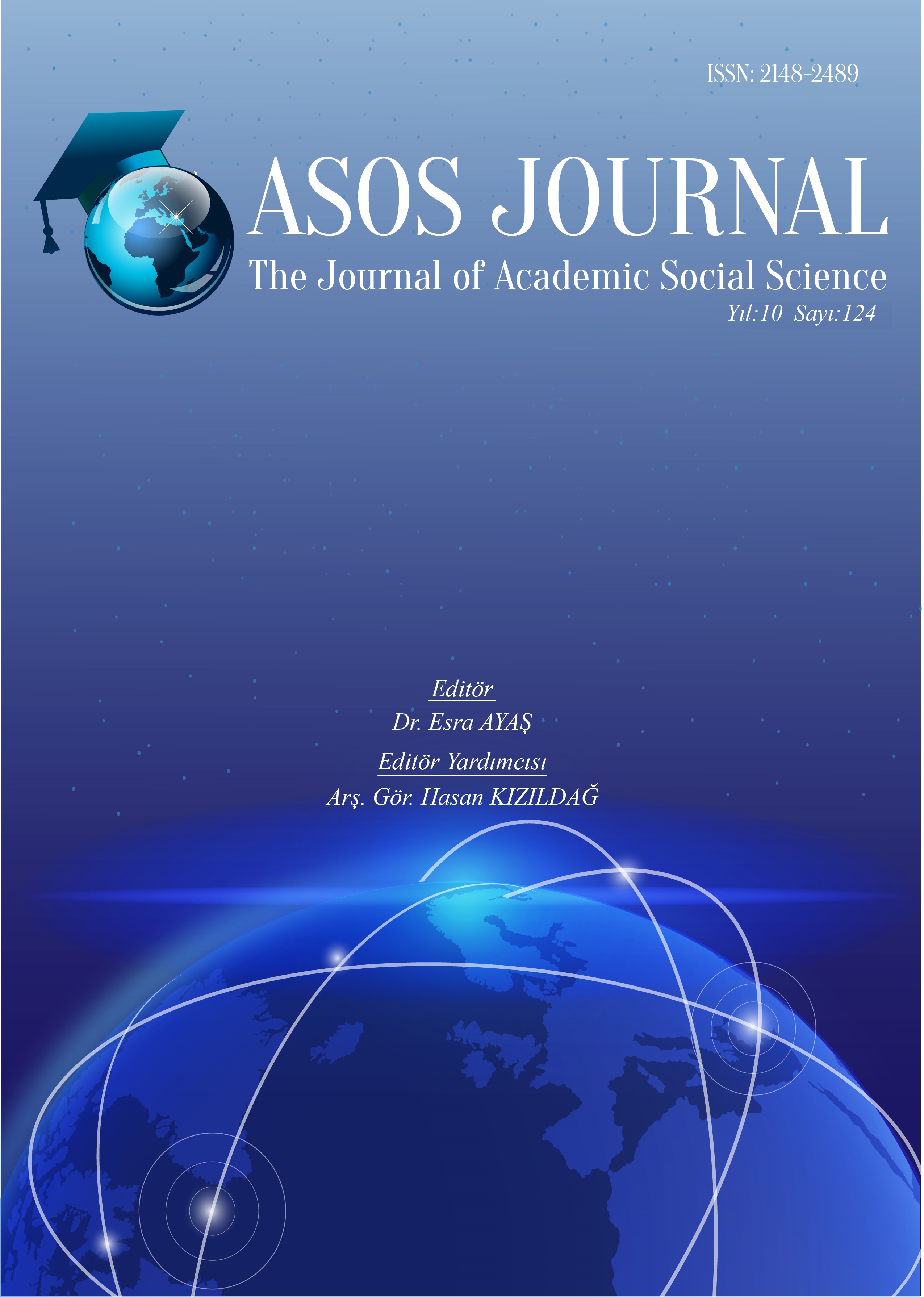Author :
Abstract
- yy ikinci yarısından sonra sanat piyasasında yankılanan ‘‘Ne olsa uyar’’ söylemi, beraberinde konvensiyonel bir yaklaşımın ilgi gördüğü, bireysel üslubun, malzeme ve teknik çeşitliliğinin yönelik zenginliğin çoğulcu bir gövdede buluştuğu bir üretim zemini hazırlamıştır. Bu yaklaşımı şiar edinen sanatçılar farklı üretim pratiklerine yönelerek, tutarlı bir bağlam içerisinde, bütüncül ve muhalif bir tavırla temeli Modernizme dayanan ‘‘kendine mal etme yaklaşımı’’nın bir parçası olan ve hazır olanın üretime dönüştüğü kolaj, pastiş, fotomontaj ve asamblaj gibi eklektik* üretimlerle günümüze değin karşımıza çıkmışlardır. Öncül olarak Duchamp, ardından Andy Warhol, Jeff Koons gibi sanatçıların da üretim pratiğini oluşturan hazır nesne, bu kez diğer kendine mal etme yaklaşımlarından farklı olarak Daniel Spoerri’nin içerik ve biçime dair yeni deneyimler barındıran üretim pratiğinin bir parçası olarak sanat piyasasında yerini almıştır. Şunu diyebiliriz ki; gündelik yaşam ve sanat arasındaki hiyerarşinin reddedildiği bir pratikiğin temsili olarak Spoerri, an’lık olana atfedilen önemle yüzleşen nesneyi, bazı üretimlerinde eklektik bir gövdede üretime dair öngörülebilir olan her şeyi reddederek zaman ve raslantı kavramlarıyla ilişkilendirken, kimi üretimlerinde ise bilinçli bir organizasyonun eklektik parçaları olarak karşımıza çıkarmış ve yaşamın an’lık değişim ve dönüşümü ile sanatın sürdürülebilirliğini eş paydada buluşturmuştur. Yapılan bu çalışmada, hayat ve sanat arasındaki sınırların ihlali tartışmalarını bir kez daha gündeme taşıyan Spoerri’nin, kimi zaman sanatı deneyimleme itkisiyle tekrarı mümkün olmayan performatif eylemler sonrasında an’ın düzeneğini zamanda sabitleme adına müdahale ettiği, kimi zaman ise tüketim çağının gözden çıkardığı nesnelerinin eklektisizt bir üslupla yüzey üzerinde organizasyonuyla üretime dönüşen ‘‘tuzak resimleri’’ne değinilmiştir.
Keywords
Abstract
After the second half of the twentieth century, the rhetoric of "Anything goes", which echoed in the art market, has prepared a production ground where a conventional approach attracts attention, where the richness of individual style, material and technical diversity meet in a pluralistic body.The artists, who have adopted this approach as their motto, have appeared at the artistic arena until the present day. They have turned to different production practices in a coherent context, yet with a holistic and critical attitude, and applying eclectically accepted methods such as; collage, pastiche, photomontage and assemblage, which were part of the "appropriation approach" based on Modernism and where the ready-made was transformed into production.The ready-made object, which initially formed the production practices of artists such as; Duchamp, then Andy Warhol and Jeff Koons, has now taken its place in the art market as part of Daniel Spoerri's production practice, which includes new experiences about content and form, unlike other appropriation approaches. It can be claimed that; as a representation of a practice where the hierarchy between everyday life and art is rejected, Spoerri has confronted the object with the importance attributed to the momentary, while in some of his productions rejecting everything that is predictable as a production in an eclectic body, in his other productions he has associated them with the concepts of time and chance and consciously brought together the momentary change and transformation of life and the sustainability of art. In this study it was discussed that Spoerri, who once again brought up the discussion of the violation of the boundaries between life and art, with the impulse to experience art, intervened in the name of fixing the mechanism of “the moment” after unrepeatable performative actions, and his "trap pictures" were mentioned where he converted the objects that the consumption era has sacrificed by organizing them on the surface in an eclectic style to transform them into a new production.
Keywords
- Artun, A. (2005). Sanatçı Müzeleri. İletişim Yayınları.
- Artun, A. (2005). Sanatçı Müzeleri. İletişim Yayınları.
- Arseven,C. E. (1998). Eklektizm. Sanat Ansiklopedisi. Milli Eğitim Bakanlığı Yayınları.Baudelaire, C. (2003). Modern Hayatın Ressamı. (A. Berktay, Çev.). İletişim Yayınları. Bourriaud, N. (2018). Postprodüksiyon. (N. Saybaşılı, Çev.). Bağlam Yayınları.
- Cevizci, A. (2009). Felsefe Terimleri Sözlüğü. Paradigma Yayınları.
- Connor, S. (2001). Postmodernist Kültür. (D. Şahiner, Çev. ). YKY.
- Gablıc, S. (2000). “Kaygı Nesneleri: Kültürel Muhalefet Tarzları”. Sanat Dünyamız Üç Aylık Kültür ve Sanat Dergisi, Sayı 75.
- Germaner, S. (1997). 1960 Sonrası Sanat. Kabalcı Yayınları.
- Gündüz, A. Y. (2021). ‘‘Bir Üretim Formu Olarak Koleksiyonculuk: LA BOITE-EN- VALISE’’. Uluslararası Sosyal Araştırmalar Dergisi, Cilt: 14, Sayı: 77, 640-650.
- Harvey, D. (1998). Postmodernliğin Durumu. (S. Savran, Çev.). Metis Yayınları.
- Kahraman, H. B. (2002). Sanatsal Gerçeklikler, Olgular ve Öteleri. Everest Yayınları.
- Kumar, K. (2013). Sanayi Sonrası Toplumdan Post- Modern Topluma Çağdaş Dünyanın Yeni Kuramları. Dost Yayınları.
- Kuspit, D. (2014). Sanatın Sonu. (Y. Tezgiden, Çev. ). Metis Yayınları.
- Koczanowicz, D. (2017). ‘‘Beyond Taste, Performance Research’’. Performance Research AJournal of the Performing Arts, 22:7, 92-99. DOI: 10.1080/13528165.2017.1353201
- Ojalvoi, R. (2011). Sürrealizm Yaşıyor / Sürrealizm ve Mimarlık: Mimarlığın Öteki Yüzünü Aramak.https://www.e-skop.com/skopbulten/surrealizm-yasiyor-surrealizm-ve-
- mimarlik-mimarligin-oteki-yuzunu-aramak/433. Erişim Tarihi: 29.11.2021.
- Sarup, M. (2017). Post-Yapısalcılık ve Postmodernizm. (A. Güçlü, Çev.). Phar makon Yayınevi.Simmel, G. (1978). The Philsophy of Money, (T. Bottomore and D. Frisby, Çev. ). Routledge& Kegan Paul.
- Şaylan, G. (2009). Postmodernizm. İmge Kitabevi.
- Wallace, I. (2014). The History of the Found Object in Art. http://www.artspace.com/ magazine/art_101/the-history-of-the-found-object-in-art. Erişim Tarihi: 29.11.2021
- Yamaner, G. (2007). Postmodernizm ve Sanat. Algı Yayınları.
- Resim 3: http://maetravels.blogspot.com/2009/10/use-rembrandt-as-ironing-board.html Resim 4: https://twitter.com/hragv/status/1302674549914427392
- Resim 5: https://www.wikiart.org/en/daniel-spoerri/eaten-by-marcel-duchamp-1964
- Resim 7: https://www.ludwigmuseum.hu/en/work/sevilla-series-no-2-dessert-eaten-young- artists-next-door-studio-hopital-ephemere-july-1991





